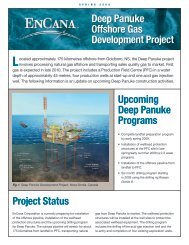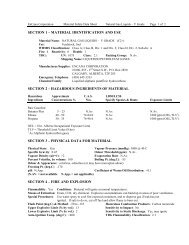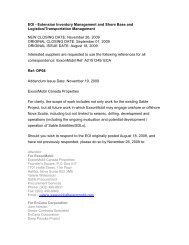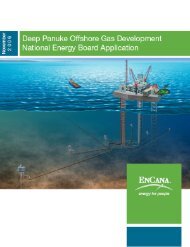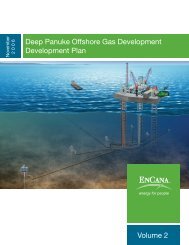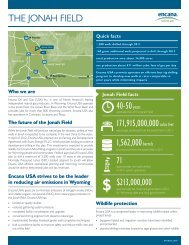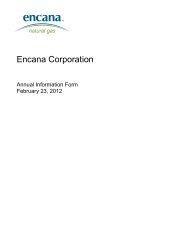Deep Panuke Project Description - Encana
Deep Panuke Project Description - Encana
Deep Panuke Project Description - Encana
Create successful ePaper yourself
Turn your PDF publications into a flip-book with our unique Google optimized e-Paper software.
2.7 Emissions and DischargesEnCana will adhere to the OWTG (NEB et al. 2002) and all applicable regulations for emissions andwaste management. Where no standards exist, best industry practice will guide EnCana. EnCana willminimize, to the extent practical, both the volumes of wastes being discharged and the concentration ofcontaminants entering the environment. A Waste Management Plan (WMP) (included in the EPP) willbe developed for the <strong>Project</strong> that will address all phases of the <strong>Project</strong> including construction,installation, operation, decommissioning, and abandonment. The goal of this plan is to minimizeoffshore wastes, discharges, and emissions and identify appropriate mitigative measures.Estimated quantities of wastes, discharges, and emissions that will be generated for both theconstruction/installation/drilling and production/operation phases of the <strong>Project</strong> are summarized in Table2.8. The table also includes summary descriptions of the characteristics of the waste discharges anddisposal procedures to meet regulatory compliance standards.2.7.1 Air EmissionsSources and types of air emissions during routine <strong>Project</strong> construction and operation will include:• exhaust from supply and stand-by vessels;• short-term flaring of the produced fluid from production wells during clean-up;• exhaust from machinery on the platform (e.g., gas turbines);• fugitive emissions (e.g., emission of volatile organic compounds from valves, filter changeouts,storage of hydrocarbons, etc.);• emissions associated with processing operations including continuous flaring for processing byproductsfrom TEG and produced water treatment systems; and• flaring of the full acid gas stream during routine maintenance of the acid gas management system(approximately 2% of operating time).The gas vented from the TEG regenerator must be continuously flared to prevent emissions of aromatichydrocarbons (BTEX) from the system. If the produced water stripping unit is required to remove residualH 2 S prior to disposal, the waste gas from this unit will be injected into the acid gas disposal well.Refer to Appendix F for details on the atmospheric modelling undertaken for their <strong>Project</strong>. Furtherinformation on routine air emissions, including generation rates, is presented in Table 2.8 and Section8.1. Information on air emissions during malfunctions and accidental events is provided in Section8.1.4.4.<strong>Deep</strong> <strong>Panuke</strong> Volume 4 (Environmental Assessment Report)• November 2006 2-46





